Learn to Appreciate an Original Sports Fabric
Too often, corduroy is simply dismissed as a poor man’s substitute for velvet, which is more typical of formal attire. But corduroy is a versatile and elegant fabric that has been worn by landed gentry, Old Money scions, preps, and countless other Classic Style aficionados for centuries.
As soft as velvet, it is more durable and easier to maintain and clean and so offers a great option for those who crave a luxurious nap, delicate hand, and impressive shape retention without compromising on longevity and the capacity for harder wearing.
Whether worn as part of hunting apparel, Prep or Ivy style, or simply as an exceptional go-to when the weather is cooler, corduroy is an impeccable option for today’s elegant gent.
In today’s guide, you will learn exactly what corduroy is, the history of this remarkable fabric, and how easily it can be integrated into your wardrobe. As trousers or sports coats, caps, or sports shirts, there is a place for corduroy in your wardrobe.
What is corduroy?
Corduroy is a textile immediately recognizable from its raised cords or ridges that run vertically along the fabric: this ridge of fabric is most correctly called a “wale.” To create this ridged texture, the fabric is woven so that its strands lie parallel to each other to form the individual cords.
These cords are separated by channels that reveal the base of the fabric. The wales can be more dense and narrow, creating a more uniform surface, or larger and widely-spaced, emphasizing the appearance of the channels.
In the market for corduroy trousers? See what Fort Belvedere has to offer!
The History of Corduroy
Corduroy Developed from Fustian Fabric
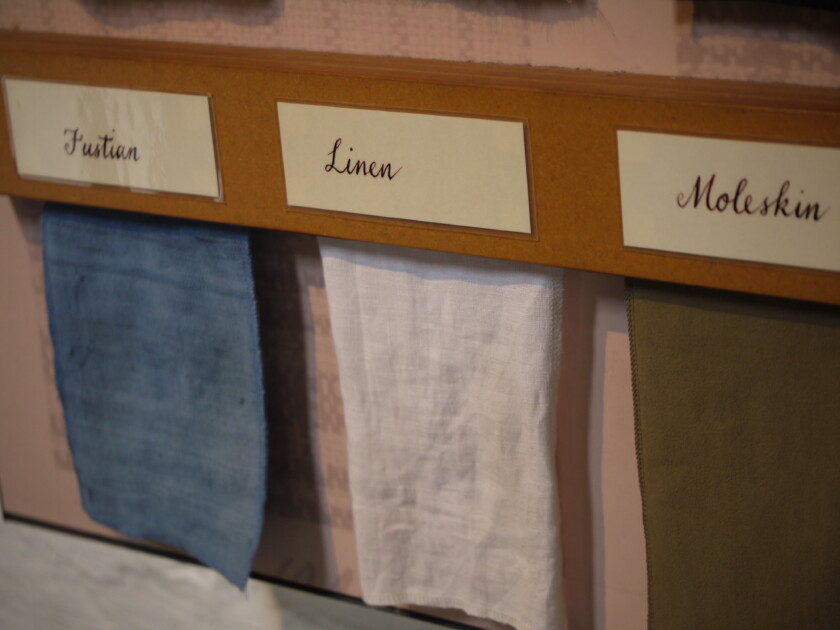
This display compares the texture of fustian, linen, and moleskin. [Image Credit: Wikimedia]
Like the closely related velvet fabric, corduroy is a variety of fustian. Fustian is a very broad term that applies to any thick, durable twilled cloth with a short nap: moleskin is another example of a common fustian fabric.
Fustian is an ancient fabric that was employed in a variety of ways throughout the ancient and medieval world, including as robes, dresses, menswear generally, and even bed hangings. It was a major product of the city of Norwich, England, during the reign of King Edward VI, where it was often used to make jackets.
The Origins of the Term
Fustian
The word “fustian” has referred to a heavy cotton fabric since at least AD 200. It is theorized that the term may be derived from the ancient city of Fustat, located near Cairo in Ancient Egypt, that was known for its textile production, providing North Africa, Europe, and the Middle East with fine garments made, especially, from linen and cotton.
Corduroy is Perfected as an Outdoor Fabric

Along with tweed, corduroy was one of the first modern “performance fabrics,” favored for athletic, sporting, and leisurely activities.
During the 18th century, as modern sporting activities such as shooting, hunting, and riding became increasingly popular with the otherwise city-dwelling English gentry, tailors sought to perfect a fabric that was comfortable, provided protection from the elements, and was easier to maintain than the heavy wools or leather garments typically in use at the time.
London tailors are generally credited with perfecting a variety of fustian that was hard-wearing, could dry quickly after getting wet, and provided exceptional warmth when it was cold. This fabric was largely maintenance-free, and relatively inexpensive to make, but also had a beautiful sheen and was surprisingly soft.
Eventually, this fabric came to be known as corduroy.
Learn about tweed, another early “performance fabric”
The Origins of the Name “Corduroy”
It is not clear when the term corduroy became a separate word from fustian. There is, in fact, even considerable discussion about the meaning of the word “corduroy.” These etymologies are sometimes employed when attempting to discern the true origins of this fabric.
Corde du Roi
One of the most popular theories for the meaning of corduroy is the belief that it comes directly from the French phrase, corde du roi, which literally means “the cloth of the king.” Corduroy, however, was traditionally made from cotton or cotton and linen blends and was not historically considered especially regal or expensive: silk, and fabric made from silk, like velvet, would be much more likely to be the “cloth of the king.”
Cour du Roi
A similar theory posits that corduroy comes from “cour du roi,” which means “court of the king” in French. If velvet made from silk could be considered a royal fabric, corduroy from cheaper materials might be worn by servants who attended the court: corduroy is sometimes referred to as the “velvet of the poor.” Not coincidentally, velvet and corduroy are made with a very similar process, although when making corduroy the pile picks are bound by the warp, which creates the vertical lines.
Cord Duroy
Moving away from French etymological origins, another theory holds that the term corduroy comes from English, with “cord” referring to the cords of the fabric and “duroy” being a corruption of the word “durable,” emphasizing the hardy nature of the material.
20th Century Corduroy Styling

Michel Piccoli wears a corduroy sport coat while driving with Catherine Deneuve in this still from Les Creatures (1966) [Image Credit: Columbia Pictures]
Corduroy maintained its general popularity into the 20th century as a dependable and stylish fabric worn by men of all stations and professions. It also became increasingly associated with certain subcultures.
Working-Class Apparel
Because it was tough and strong but still visually pleasing, corduroy became very popular with working-class men. Many uniforms were made from this fabric, as were suits, jackets, and trousers intended both for daywear and for labor.
Refined Country Attire
Corduroy remained popular with country gentlemen who continued to wear it as an ideal sporting attire while enjoying leisure and athletic activities on their country estates.
Alternative Elegance
Perhaps harkening to its position as a working-class fabric, corduroy was increasingly adopted in the 20th century by academics and intellectuals, especially amongst the Parisian bohemian set.
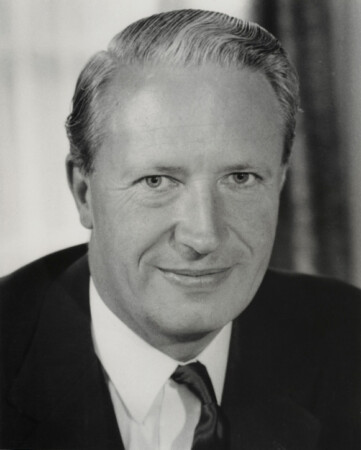
[The Beatles] “saved the British corduroy industry.”
Edward Heath, president of the English Board of Trade, 1963-1964
How corduroy was saved by
The Beatles
In the early 1960s, corduroy was almost exclusively the domain of students and schoolboys, workers, farmers, and professors, and so the industry was in decline with few opportunities to expand. That all changed when the hugely popular singing group The Beatles began wearing corduroy suits as a fashion statement, almost single-handedly starting a new boom in corduroy amongst young people.
Prep and Ivy Style
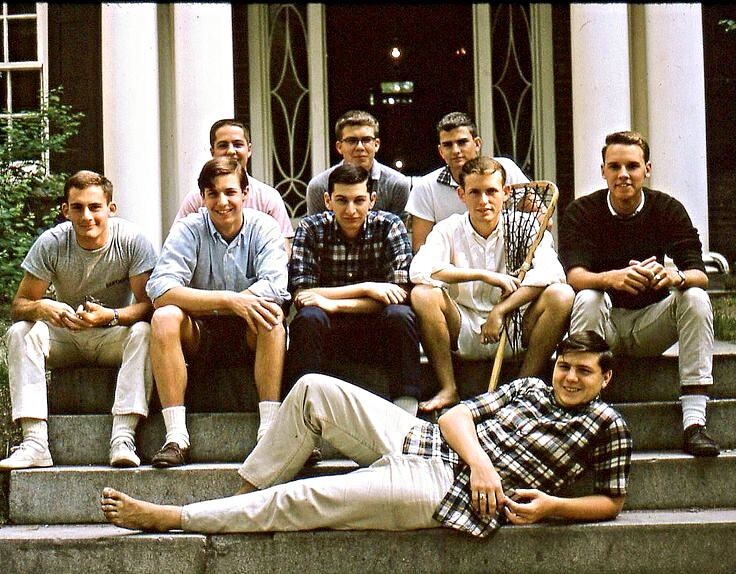
Preppy style worn by Dartmouth freshmen in 1964.
The adoption of corduroy by intellectuals spread it on college and university campuses amongst teachers and professors, and by the 1950s corduroy was increasingly worn by students who made it a staple material in the Prep and Ivy styles. Students from Princeton, alma mater of F. Scott Fitzgerald, and Dartmouth were early adopters of corduroy styling in youth culture outside of the working classes.
Learn more about Prep Style!
Corduroy Today
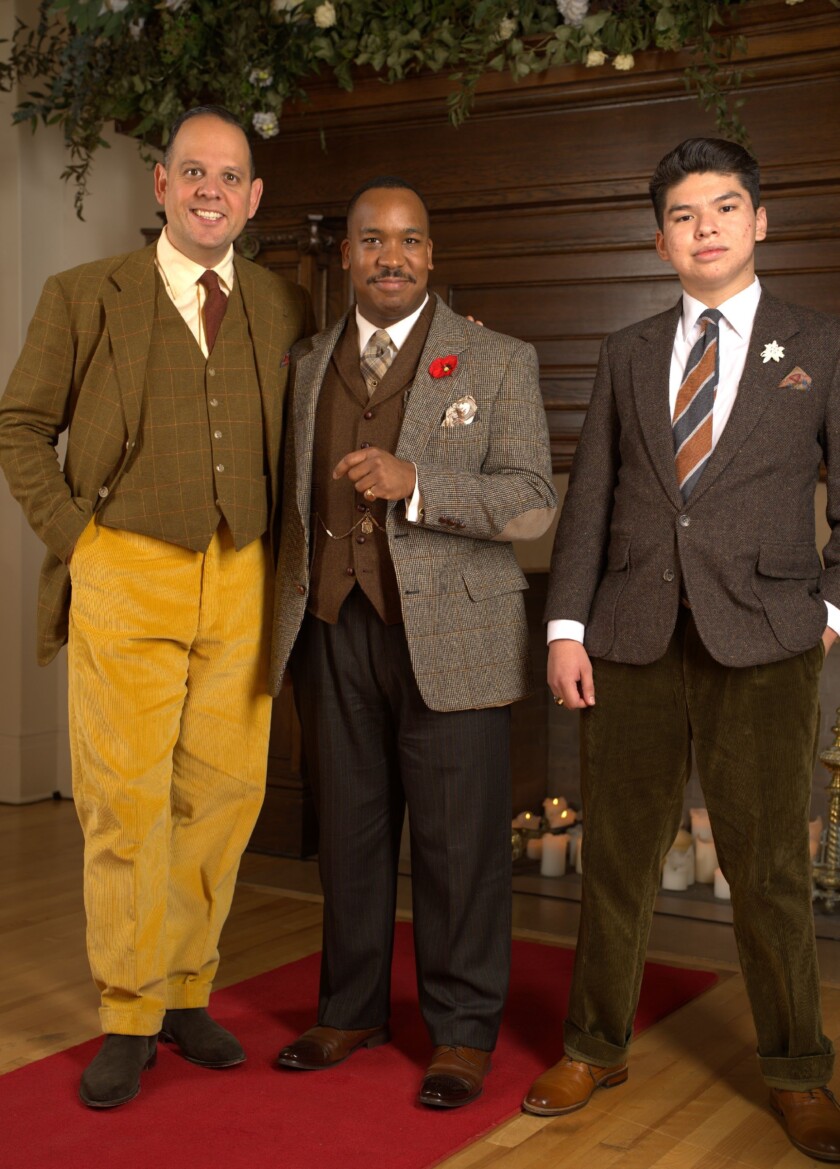
Corduroy remains a popular fabric for those wishing to dress in the style of English country gentlemen.
Since the 1970s, corduroy has enjoyed ebbs and flows of popularity but always remained a fixture within the Classic Style community. While still associated with academic types who pair it with tweed and those seeking to channel a distinctly Anglophilic country-style aesthetic, corduroy is increasingly viewed as comparable to or even superior to other fustian fabrics like velvet and has certainly set itself apart as its own unique textile for the modern gentleman.
Corduroy Guide FAQ
What is corduroy?
Corduroy is a fabric made of tufted cords that, as an extra set of fiber, are woven into a base fabric to create prominent vertical ridges known as “wales.” Corduroy is a type of fustian fabric that is known for being both very soft and durable.
What does the name “corduroy” mean?
There are three likely origins of the term “corduroy.” One theory is that it comes from cour du roi, which means “court of the king,” and another is that it comes from corde du roi, which means “cloth of the king.” A third theory posits that it comes from the English “cord duroy,” which is a corruption of “durable cords.” In our opinion, the first theory is the most likely.
What is wale?
“Wale” refers to the ridges that feature on corduroy fabric. Each wale is made as a column of loops that run vertically on the fabric, corresponding to the warp of woven fabric. Wales can be thinner or thicker depending, usually depending on their density. A lower wale count indicates thicker wale because fewer wales can “fit” within the one-inch area. Wale count usually varies between 1.5 to 21 wales per inch, with the former being quite broad and the latter very fine: the finest corduroy wales are sometimes called “pincord.” Most corduroy garments have a wale count of between 8 and 12: in general, articles worn on your bottom half look best with a lower wale count and articles on your top half with a higher wale count.
How was corduroy originally worn?
Fustian, a type of fabric very similar to corduroy, has been worn since at least AD 200 as both a decorative and a working fabric. During the 18th and 19th centuries, corduroy was increasingly worn by English country gentlemen while engaged in rough-and-tumble activities on their estates such as hunting, shooting, and hiking. Corduroy was later adopted by the working classes before making its way into academic circles. Today, anyone can wear corduroy as part of Classic Style.
Can men wear corduroy?
As a plush and soft fabric, corduroy became heavily associated with women’s fashion in the 1990s and early 2000s. For most of its history, however, corduroy has been associated with men and to this day corduroy is one of the most popular and stylish materials for men’s trousers, jackets, suits, accessories, and even outerwear.
Are corduroy garments seasonal?
Corduroy seasonality depends upon the weight of the fabric and the nature of the garment. In general, corduroy can always be worn in cool and cold weather, and can usually be worn in warm, if not always hot, weather. Jackets tend to be more seasonal because they cover a warmer portion of the body and therefore trap more heat. Trousers can always be worn three-quarters of the year and may even be wearable in hot weather.
Is corduroy currently fashionable and on-trend?
Yes, it is. While corduroy is a timeless fabric within the realm of Classic Style, it is enjoying something of a moment within the larger realm of fashion, buoyed by interest in men’s corduroy trousers as a plush, decadent, and hard-wearing alternative to skinny jeans. Wide-leg pants like corduroys represent an increasing portion of sales of men’s pants because their excellent drape, comfortable feel, and flattering fit look better on a wider array of body types than other popular types of trousers.
Are corduroy trousers worn in a similar way to jeans?
Like denim jeans, corduroy trousers can be worn with most casual ensembles, such as a polo shirt, sports shirt, or button-up; they tend to appear too bulky, however, when worn with t-shirts or sneakers. Unlike jeans, however, corduroy trousers are better able to elevate and dress up an outfit to maximize their styling potential, especially with liminal clothing items like overshirts, sport coats, and loafers.
What level of formality is corduroy?
Corduroy garments can be worn as part of almost every day dress code, from Casual to Business Casual. In all but the most formal office environments, corduroy is also acceptable as day business attire when it is dark blue, dark gray, brown, or neutral colored. While there are some examples of novelty evening attire made from corduroy, in general, this fabric is too casual for formal occasions such as Black Tie and certainly never for White Tie.
Fort Belvedere Stancliffe Corduroy Trousers
Inspired by the Golden Age of Menswear, these corduroy trousers are ready for the future! With a true high-rise waist, double button waistband, and flapped coin pocket, they are fully cut but taper below the knee for a contemporary silouette that is pure elegance. The corduroy fabric features a versatile 8-wale density, ideal for trousers, and was milled in Italy and assembled in Portugal with an eye towards the finest tradition of English-heritage corduroy.
Find our entire collection here!
Corduroy Fabric Characteristics

Exceptional corduroy begins with an exceptional fabric.
Material
The best corduroy is made from natural materials
Traditionally, corduroy is made from cotton. In the past, corduroy was also made from cotton and linen blends and, occasionally, from more decadent materials like wool and cashmere. Wool and cashmere corduroy tend to be very stiff and have an unexpected drape that can cause odd creases, due to the texture of the fabric.
Therefore, cotton is usually the superior material for corduroy. In particular, seek out quality long-staple cotton that is woven with a preponderance of warp threads for the best possible effect.
Be wary of synthetic corduroy
As is usually the case, synthetic fabrics should be avoided when selecting corduroy. Stuffy and lacking in breathability, synthetic fabrics may be less expensive but they are inferior in every way to natural fabrics: they wear heavily on the skin, are prone to damage, and are difficult to clean.
Don’t be too
“Tuft”
The threads used to make cheaper corduroy are often tufted, to make the fabric feel softer. However, these threads are more likely to unwind, compromising the garment. The best threads will be tightly woven for a durable overall garment: while they may initially feel stiff, they will eventually break in and feel extremely soft while maintaining an elegant drape.
Weight
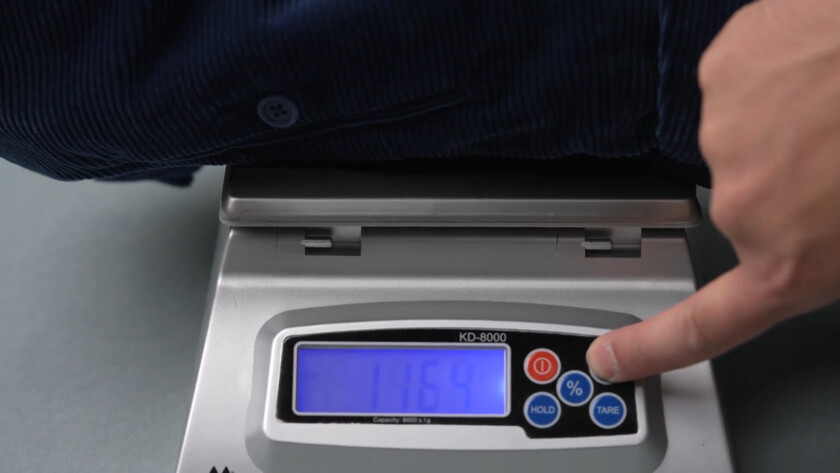
Heavier-weight fabrics will generally last longer and drape more elegantly than lighter fabrics.
With fabrics, weight is essentially the density of the weave within a given area. Medium-density corduroys measure between 270-350 grams per square meter or 9.5 to 12.5 ounces per 10 ¾ square feet. High-density fabric will have over 600 grams, and some of the best corduroy makers go even higher: Polo corduroy trousers have a density of around 800 grams and Fort Belvedere corduroys have a density of over 950 grams per square meter.
The inferiority of lightweight
Cords
Corduroy that is lightweight, or less dense, can initially feel lighter on the skin, but it is flimsy and prone to faster wear or even tearing: the cords themselves will wear down more quickly and the fabric will hang lankly on your frame. Oftentimes, the cords will actually wear away as you wear them, resulting in unsightly bald spots.
Heavier corduroy with a denser weave will have superior durability because it is physically thicker and maintains a cleaner, more even drape on your body for more pleasing lines. Denser corduroy can feel stiffer at first but after a few wears it will break in beautifully for a luxuriously soft feel.
Learn more about Fort Belvedere corduroy weight
Durability
The preceding fabric characteristics are the primary determinant of how durable a piece of corduroy is. This durability refers both to how well the fabric resists damage and how long it can be worn before it begins to deteriorate, tear, or break, especially in high-friction areas like the groin.
Various tests have been developed that attempt to quantify the durability of fabric, and one of the most efficacious is the “double-rub” standard.
Fast Facts
“Double-rubbing” refers to a standardized system of calculating how durable a fabric is based on its ability to withstand abrasion. In this test, a mechanical, repeatable process mimics the action of a hand running forward and backward, or double-rubbing, a piece of fabric. The resulting number illustrates how many “rubs” a fabric can endure before becoming compromised.
For reference, lightweight fabrics that are not worn often, like a voile evening shirt, might have a double-rub rating of 8000. Medium-weight fabrics, like a denim jacket, could have around a 13,000 rating. Anything over 15,000 is rated for superior durability and longevity, and only the finest and hardiest corduroy will have a rating of 20,000.
Nap
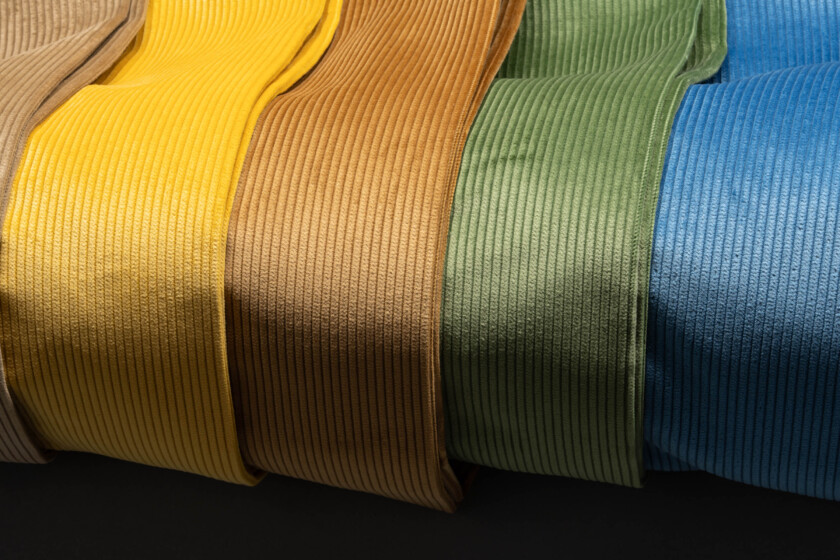
High-quality corduroy will have a gorgeous nap that seems to shimmer in the light. The resulting interplay of light and shadow can even impart a two-tone effect, widening the tonal range of the trousers, like these examples from Fort Belvedere.
Nap refers to the distinctive, directional texture of a fabric, and on corduroy the nap offers remarkable opportunities for improved visual interest.
The best corduroy garments will have a uniformly arranged nap, so that, like the grain on wood, it flows in the same direction on both the front and back of the garment. This pleasing effect contributes to a holistic textural appearance and gives the fabric an incredible luster.
Cheap corduroy, conversely, will appear dull and the nap will not be arranged in the same direction, which has a jarring effect. The nap will also be flimsy and is often the first part of the fabric to be noticeably worn away.
Wale

Note the visual difference between these 5, 8, and 10 wale corduroy trousers.
Corduroy is generally measured by what’s referred to as the “wale’ of the cord, which is the number of ridges per inch on the fabric; the cords on corduroy are most correctly called “wales.” The lower the wale number, the thicker the wales will be.
Wale count can vary widely, from 1.5 wales per inch to 21 wales per inch. In most cases, however, a wale count between 8 and 12 will prove most versatile.
Which wale count is
Right for me?
As a rule of thumb, a lower wale count will appear most visually pleasing on trousers, because the wider wales help to ground the ensemble. Conversely, a higher number of wales will appear best on shirts and jackets, because the finer appearance is more flattering to the upper body, helping your chest and shoulders to appear like a wider, more cohesive whole.
Backing
Corduroy fabric typically has one of two backing types.
Plain Back
A plain backing, usually called a Tabby Back, has a plain and simple face typical of most fabrics. It is cheap and easy to make but the plain backing can feel rough against the skin, and the fabric is more likely to break down with regular wear-and-tear.
Twill Back
On higher-end corduroys, it is more common to see a Twill Back, also known as a Genoa Back, which visually resembles the cords of the front of the fabric. The tightly-woven twill of this backing helps to maintain the structure of the garment and is almost like a natural lining, as it feels very soft against the skin.
Colors

Sedate, matte corduroy imparts a sense of dignity and elegance.

Vibrant corduroy colors provide the perfect pop of visual interest.
With its plush texture and visual weight, corduroy can be dyed essentially any color in the rainbow and appear visually pleasing. Therefore, you should select colors that integrate well with your wardrobe, your preferred styles, and the season in which you intend to wear them, and ignore trendy colors: chances are, no matter which color you choose, corduroy will appear elegant and refined.
The most versatile colors that will pair easily within Classic wardrobes include dark brown, tan, cognac, olive green or drab, khaki or taupe, infantry blue, and navy. If you are building out your collection or prefer to wear more vibrant colors, consider also light green, yellow, bright red, and burgundy.
Master the colors of fall!
Understanding the
Dyeing Process
As a hard-wearing fabric that should last you for years, it is possible that the dye on your corduroys will be compromised before the fabric is. This is especially likely to happen if the garments are pigment-dyed: in this process, the dye is applied only to the surface of the garment prior to it being cut and sewn. Over time, pigment-dyed color will fade, especially when washed. The best corduroy will be fabric dyed: the dyes penetrate deeply into the material to resist fading.
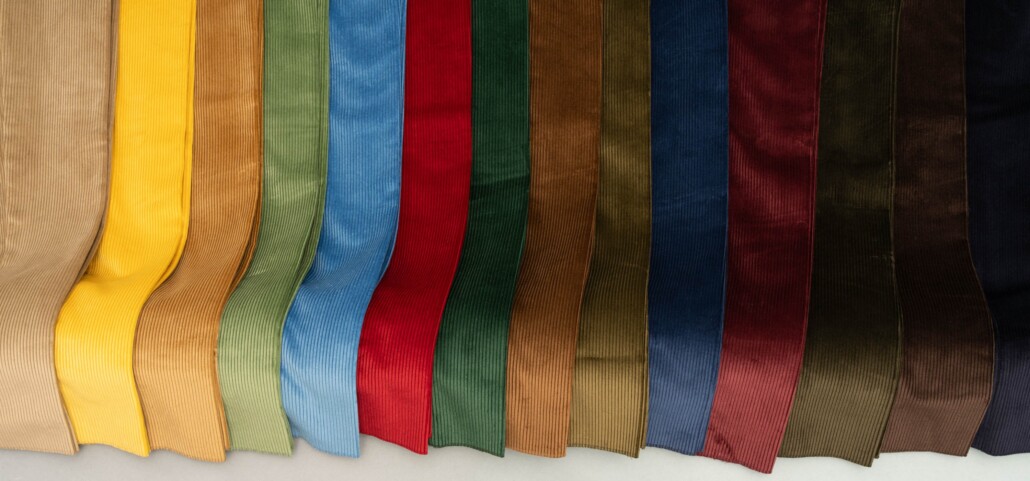
Fort Belvedere corduroy is available in every color of the rainbow, and more!
RECOMMENDED
Stancliffe 8-Wale Corduroy Trousers
No matter the season, occasion, or ensemble, Fort Belvedere has corduroy trousers in every color that you could desire. Our material is first fabric-dyed to ensure a rich, deep, and consistent color that penetrates into the fibers themselves to reduce fading. The result is an unparalleled depth of color that you can enjoy for years to come, in an array of colors you will be hard-pressed to find anywhere else.
Shop All Fourteen Colors!
Common Corduroy Garments

Corduroy can be used to make almost any garment you can imagine.
Trousers
Trousers are one of the first corduroy items in which you should invest. Durable and rugged, well-made corduroy can handle the rigors of regular wear and the best examples will be reinforced at stress points like the groin and knees to provide a lifetime of service.
The weight of corduroy offers an especially pleasing drape that is suitable for the lower half of the body, and corduroy pairs with a remarkable range of other fabrics, garments types, and colors, thanks to the lustrous sheen of high-quality corduroy: the shimmering effect of the nap creates a wider range of color tones that are easier to pair.
While corduroy trousers will not have the versatility of a wool pair, they can be easily dressed up or down to suit all but the most formal day attires.
Jackets
Reflecting its outdoor heritage, it is typical for corduroy suit jackets and sport courts to feature more casual detailing, including center vents, patch pockets, and even throat latches. If you prefer a more formal appearance, opt for details like side vents and flap pockets.
Smoking jackets are occasionally made out of corduroy, and as such are sometimes worn as part of Creative Black Tie attire. Contemporary Black Tie may also feature corduroy elements, but this functionality is not typical of Classic Style.
When you are first building your Classic Style wardrobe, it is usually best to invest in a corduroy sport jacket before a full suit. In all likelihood, an odd jacket will offer more versatile styling potential.
Other Garments and Accessories
A wide variety of menswear accessories can be made from corduroy, such as caps, shirts, waistcoats, and vests. In general, these items will appear more casual but benefit from excellent functionality and unique, laid-back styling potential.
Don’t tremble over
Texture
The elegant appearance of quality corduroy wale is surprisingly versatile for such a strong and dynamic texture. In the example on the right, corduroy trousers are seamlessly integrated into a look that includes a slubby wool jacket, a knit cardigan, and a silk day ascot. The liminal texture of the fine corduroy, which is ridged but with a soft hand, bridges the gap between these various elements.
How to Buy Corduroy
Finding the Correct Size
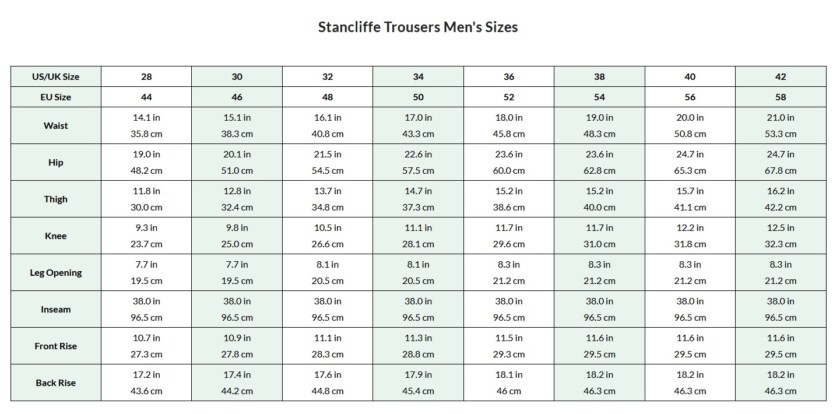
The best corduroy makers will provide a thorough accounting of how their garments fit with the measurements you need to find your correct size. Here is an example of a sizing table for Fort Belvedere corduroy trousers.
Because it is both a physically and a visually thicker fabric, corduroy garments can be more difficult to find a pleasing fit for than thinner fabrics. The best corduroy manufacturers will have detailed information explaining the exact body measurements that suit the cut of their garments.
In particular, these measurements will take into consideration the real proportions of the actual human body: trousers with a smaller waist, for instance, should have more tapered legs to reflect the realities of a slim figure, while wider waists should ensure sufficient room in the thighs for easy movement.
Able to be
Altered
The best corduroy garments include a fabric reserve, allowing you to let out the garment to accommodate a better fit or slight weight gain. At Fort Belvedere, all of our trousers come with a reserve of 3 inches / 7.5cm in the waist and about 1.5 inches / 3.8 cm in the legs.
Classic Construction
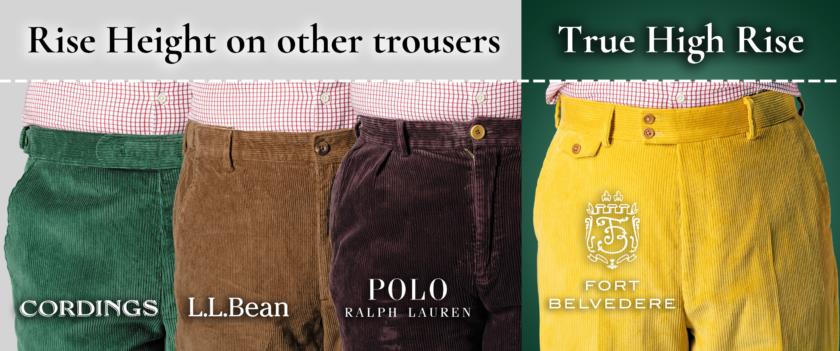
This graphic illustrates the variations in rise height for several modern corduroy brands.
Corduroy is not conducive to a slim fit, so expect the highest quality corduroy garments to feature a fuller, drapey cut typical of the Golden Age of Menswear. To ensure maximum comfort and the most pleasing possible lines for the legs, a higher rise is typical for corduroy, although only a handful of brands still offer a genuine high-rise.
Details that Indicate Quality
Because of the excellent qualities of the material, almost every major menswear brand offers items made from corduroy. To help you find the best possible product, be aware of these quality hallmarks that indicate superior corduroy material and construction.
Hallmarks of Quality Corduroy Garments
1

Natural Lining
Cheap synthetic lining around the body or waistband can feel stuffy and encourage excessive sweating. The best corduroy will feature natural lining or breathable synthetics like bemberg.
2
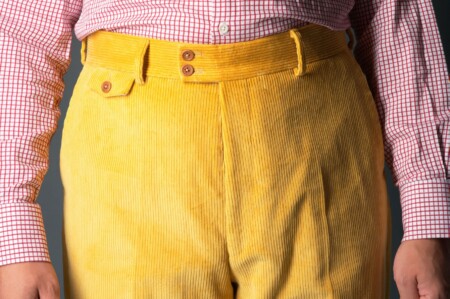
Quality Buttons
If a maker will cut corners with buttons, it usually indicates that they have cut corners in other aspects of production. The best buttons will be made from mother-of-pearl, horn, or corozo, a nut that resembles ivory but can be sustainably harvested from trees.
3
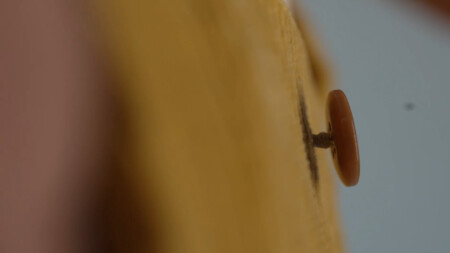
Long Shank
A long shank with sturdy thread is necessary to ensure that the thick fabric of corduroy does not put pressure on the button; it is also easier to button and unbutton and more comfortable for you.
4

Quality Hardware
From the closure at the waist to the zipper and other materials, heavy-duty, durable hardware is an essential component of corduroy garments: if the zipper gets stuck, you won’t get much use out of your clothing.
5

Deep Pockets
The heavy drape of corduroy allows you to fully employ your pockets without having to worry about unsightly bulges. This is especially true if garments are made with features like recessed pockets, which allow more secure and more discreet storage of items that won’t spoil the lines of your trousers.
6
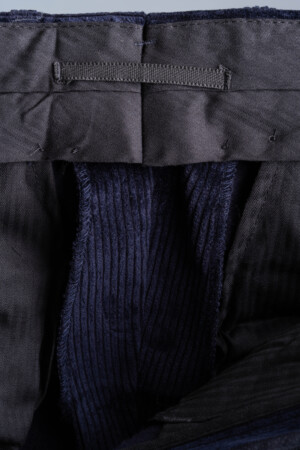
Hanger Loop
Located on the interior rear of the trousers, a hanger loop provides a convenient way to store trousers when a hanger isn’t handy. This little detail illustrates that the maker has taken an extra design step to improve your wearing experience.
Brands That Carry Corduroy
The following brands all offer corduroy trousers at various price points. Utilizing the quality hallmarks highlighted in this article, you can determine if any of these brands could suit your sartorial needs.
A Special Offer from Fort Belvedere
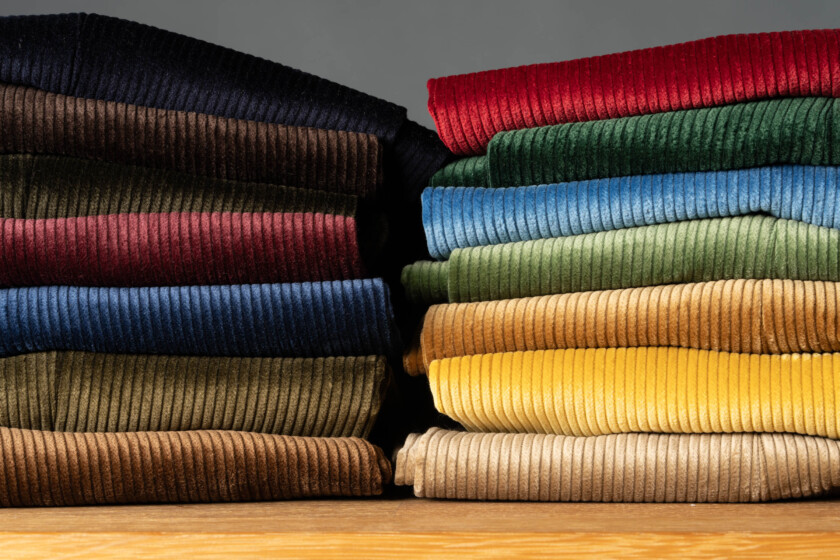
At Fort Belvedere, we are happy to pass along savings to you!
When you buy multiples of Fort Belvedere products, it benefits our bottom line, so we are happy to benefit your bottom line in return!
If you buy two pairs of our trousers, we’ll help you save $60. If you buy four pairs, you’ll save $180, and you’ll save $410 with six pairs. The more you buy, the more you save!
How to Wear Corduroy
Seasonality
Due to its tight weave, corduroy is a relatively insulating and relatively warm fabric, especially when it is kept dry. As such, it may be too heavy for hot weather or warm weather if you are prone to overheating. In most circumstances, however, you will be able to wear corduroy for three-quarters of the year and perhaps longer depending on your local climate.
Formality
Corduroy garments can be worn as part of almost every day dress code, from Casual to Business Casual. In all but the most formal office environments, corduroy is also acceptable as day business attire when it is dark blue, dark gray, brown, or neutral colored. While there are some examples of novelty evening attire made from corduroy, in general, this fabric is too casual for formal occasions such as Black Tie and certainly never for White Tie.
Cuts for Corduroy Garments
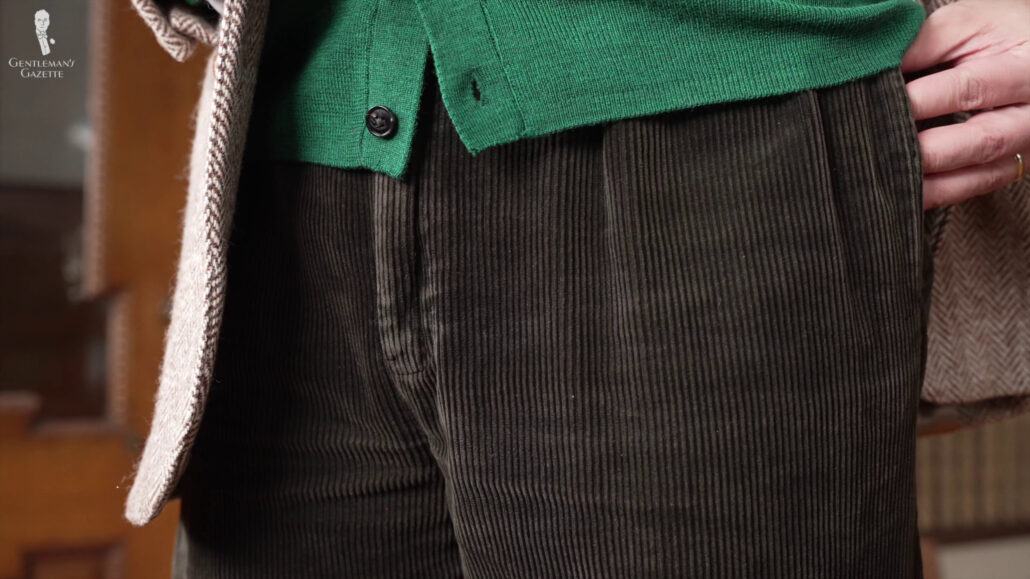
A fuller cut will flatter all figures thanks to the weight of corduroy fabric.
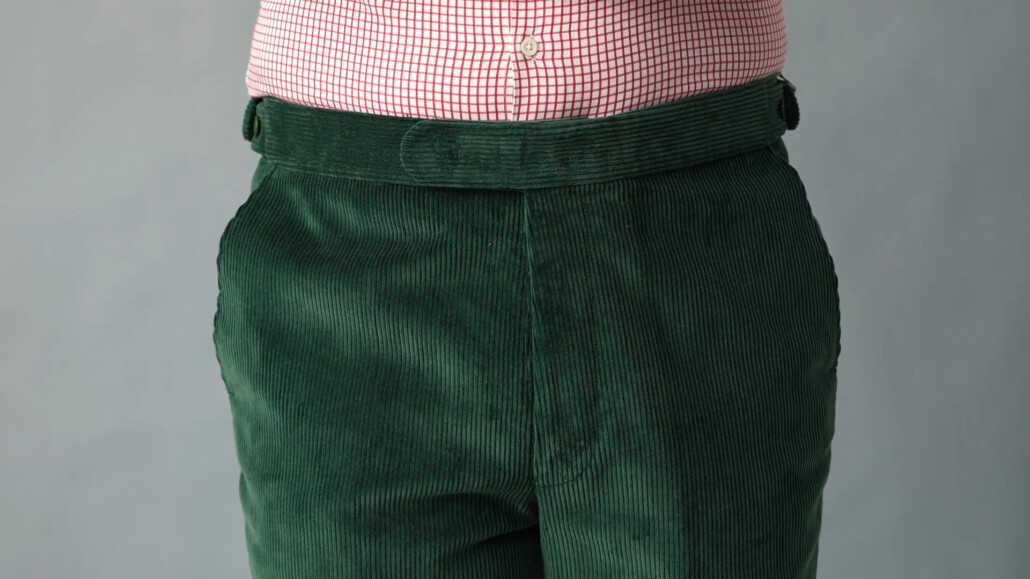
Most corduroy trousers will appear more pleasing with a flat front.
Because it is such a heavy and drapey fabric, you should avoid tight and overly slim cuts for both corduroy jackets and trousers. A fuller cut will highlight the beautiful weight of the fabric and flatter your figure, no matter your shape.
When it comes to trousers, because of the thickness of corduroy, a higher rise that sits at or above the navel will be more comfortable as it will not bunch or dig into your belly when sitting down.
Unless your trousers have a very fine, high wale count, most corduroy trousers will look best with a flat front: pleats can spoil the strong vertical lines typical of thicker cords.
Corduroy that is
Vintage
Vintage corduroy was defined largely by its unique colors, including gunmetal gray, as well as unusual wale counts, from the very wide to the extremely fine. In general, garments from the 1950s and 1960s will feature a timeless cut that won’t appear dated. Some items from the 1970s and 1980s, however, may have trendier styling that is more noticeable.
How to Style Corduroy
An Iconic Corduroy Ensemble: The English Country Gentleman
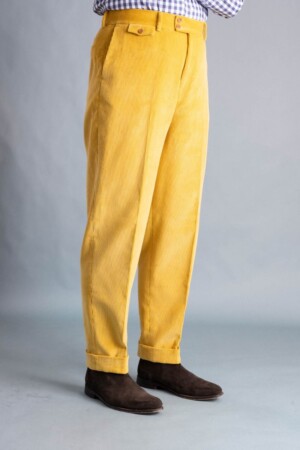
Fort Belvedere
Stancliffe Corduroy Trousers in Goldenrod Yellow
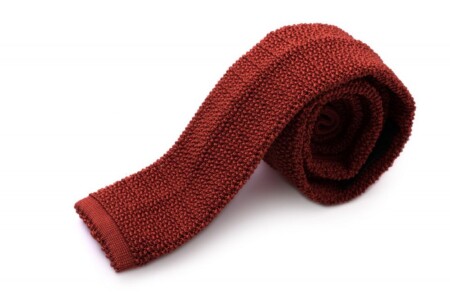
Fort Belvedere
Knit Tie in Solid Rust Orange Silk
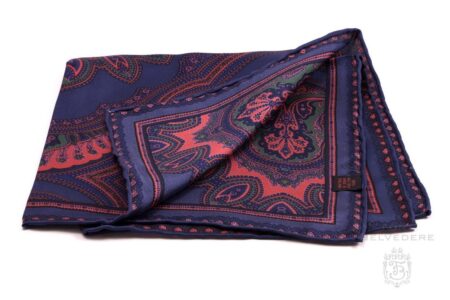
Fort Belvedere
Silk Pocket Square in Dark Blue with Orange and Green
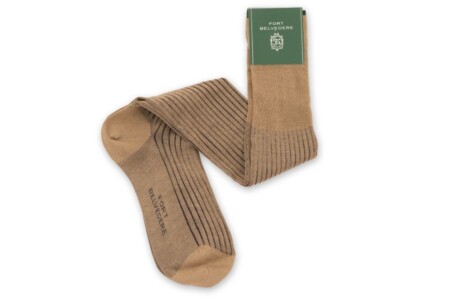
Fort Belvedere
Khaki and Navy Shadow Striped Socks in Fil d'Ecosse Cotton
More Casual Corduroy Looks
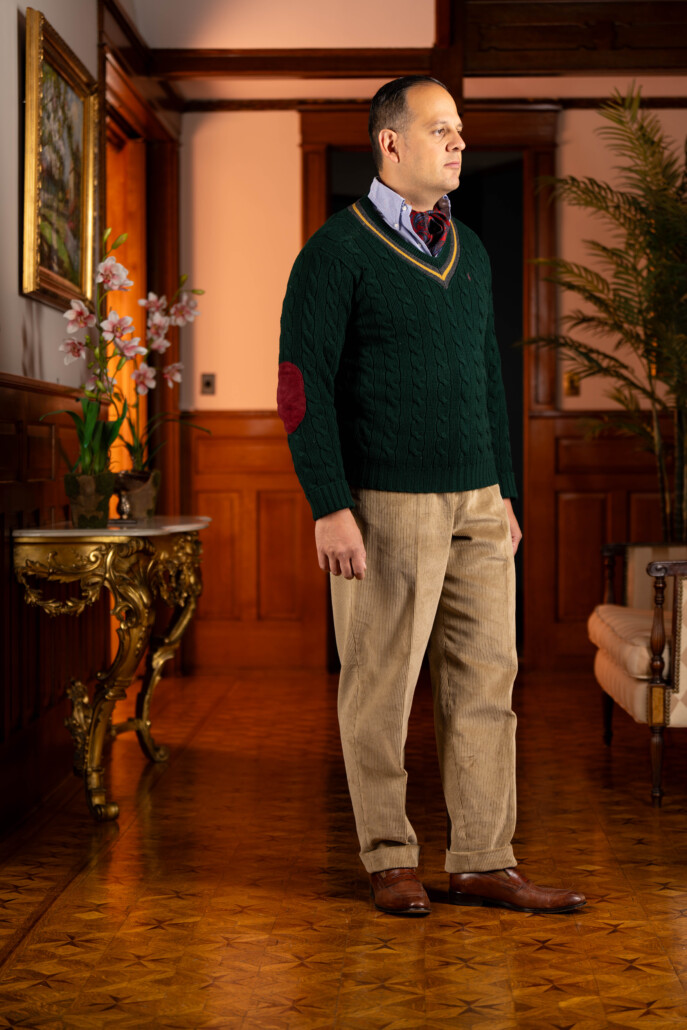
Let’s create a sedate casual look with pale taupe corduroy trousers, starting with a comfortable bottle-green sweater with yellow contrast detailing. A light blue dress shirt helps us transition to colorful neckwear, in this case, a bold red and blue madder silk ascot. The lower half of the outfit is more tone-on-tone: warm medium-brown loafers with khaki and dark red socks.
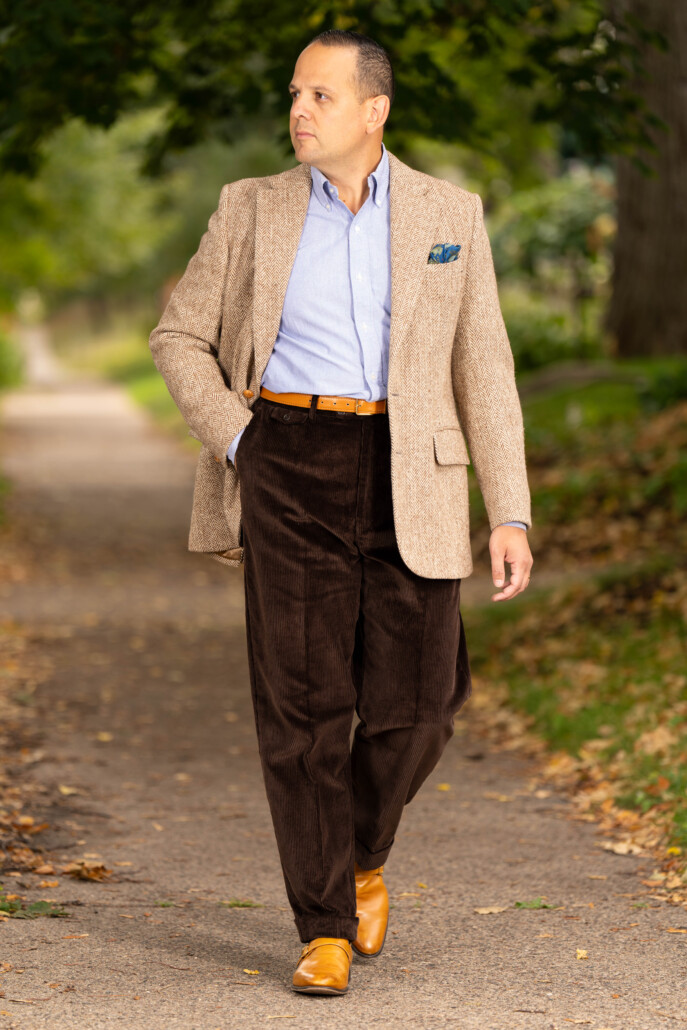
In this look, dark brown corduroy is paired with a wheat herringbone sport coat and blue shirt, set off by a darker blue pocket square. A tan belt bridges the transition from the bright shirt to the dark trousers. The bright tan monk straps finish off the look with flair, but transition harmoniously into the dark trousers thanks to gray and turquoise striped socks.
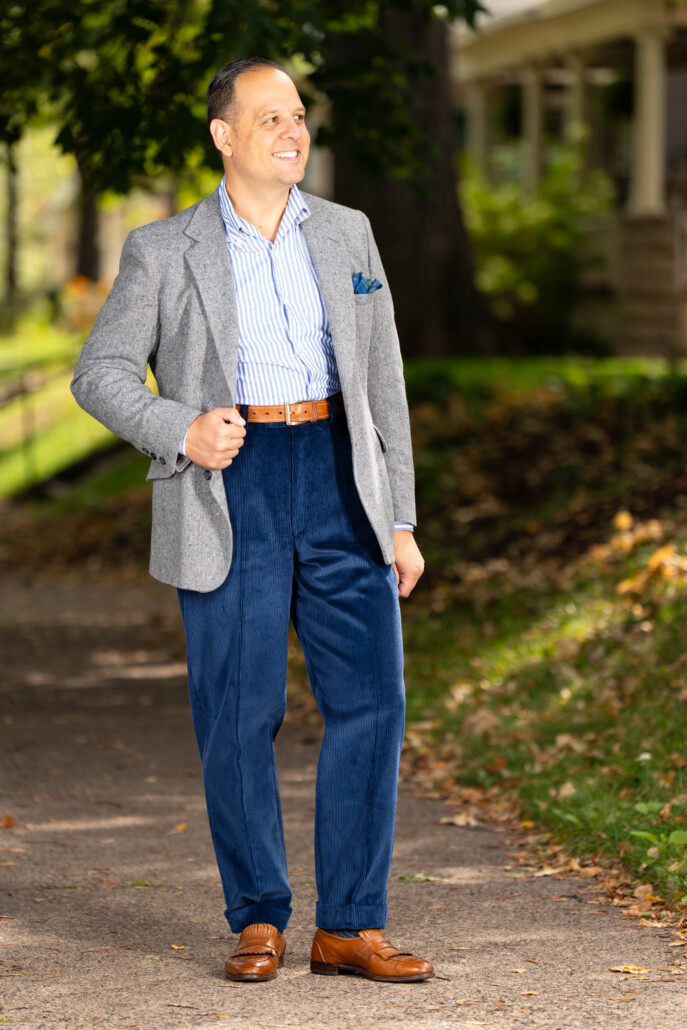
For a casual look that is cool and breezy, consider infantry blue corduroy trousers with a blue and white striped shirt and a light gray sport coat, with a playful blue and green pocket square. We’ll keep things bright and light with a tan cognac belt and tan loafers with gray and turquoise socks, which make the trousers appear even more vibrant.
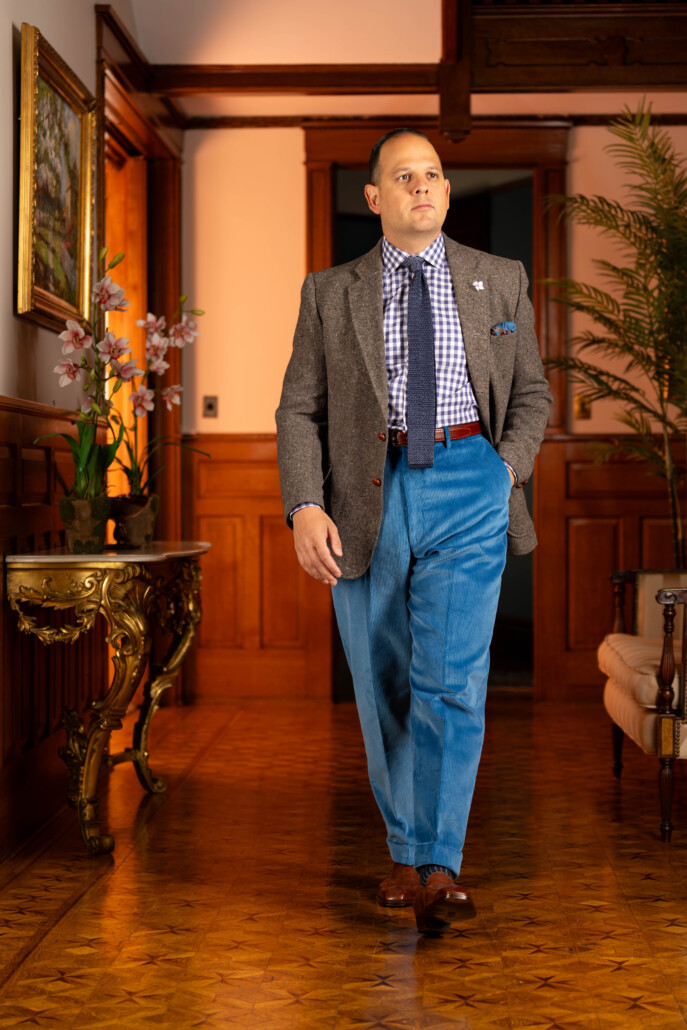
Who says that neckwear always has to be formal? Here a Prussian blue knit tie and azure blue corduroy trousers remain delightfully fun and casual when paired with a white and purpled checked shirt and boutonniere provides a subtle finishing touch. To capture the tonal range of the ensemble, we’ll conclude with dark and light blue socks worn with pebbled loafers and a chestnut belt.
How To Pair and Accessorize

Corduroy, especially in a stately color like brown or blue, can be easily paired with a variety of accessories. In the above look, an emphasis is placed on tonally-similar colors with unique textures: note especially the dynamic effect of the silk knit tie and the rough pocket square.
The elegance of
Odd Garments
Because it is such a versatile foundation for an outfit, corduroy trousers offer the ideal chance to highlight an odd jacket or a waistcoat-and-jacket combination. Whether in a contrasting color or a similar shade, corduroy has the visual bulk necessary to set off any jacket, helping your entire wardrobe go further thanks to the potential for more combinations.
More Formal Corduroy Looks
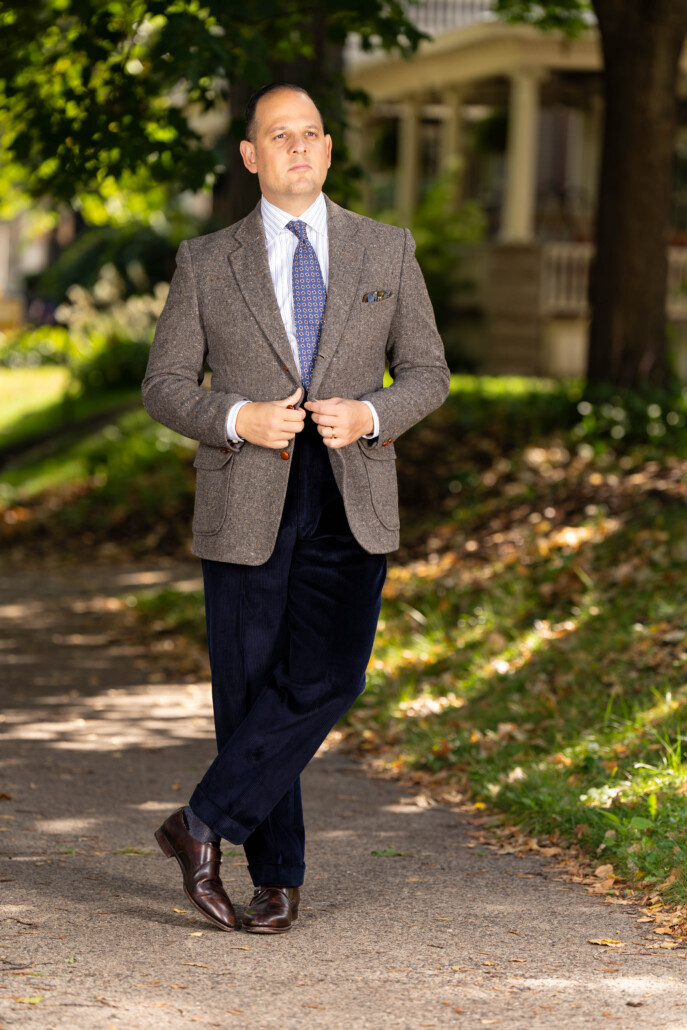
A mottled-gray sport coat with football buttons is the perfect companion to these midnight blue trousers, especially when paired with a blue and brown striped white shirt and blue tie with micropattern, topped off by an elegant pocket square. Two-tone socks in navy blue transition elegantly into mottled dark cognac and brown monk straps.
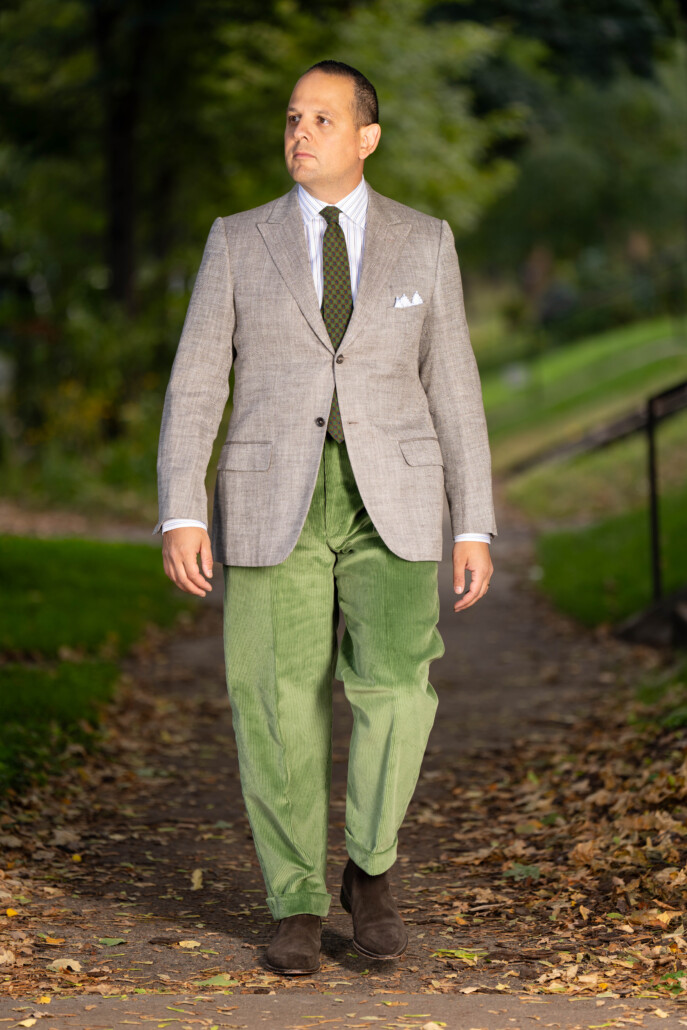
Combine a herringbone gray sport coat with sage green corduroy and a brown, white, and blue striped shirt and an olive green tie with micropattern. Add green and brown socks with dark chocolate ankle boots and a belt to match. Top everything off with a white pocket square with blue contrast stitching to harmonize with the shirt.
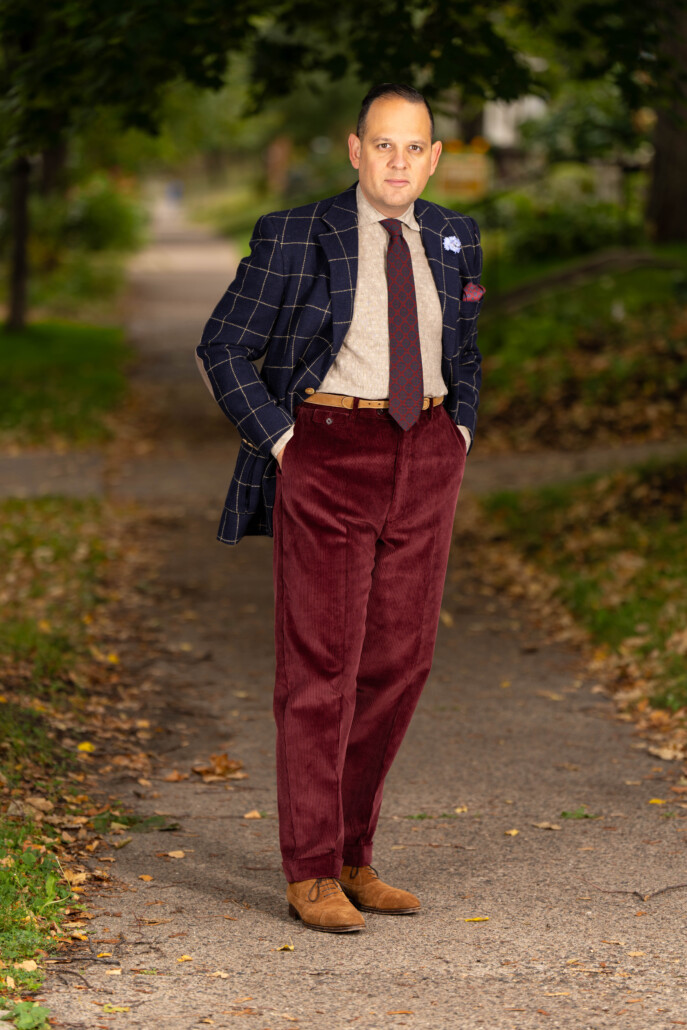
Rich, plush colors appear especially decadent as maroon corduroy trousers are combined with a deep blue window-paned sport coat. A creme shirt adds warmth to the dark red and green tie. A light blue boutonniere adds a flash of color and a red and dark green pocket square harmonizes the jacket with the trousers. The darker tones transition into tan suede oxfords through two-toned khaki and dark red socks.
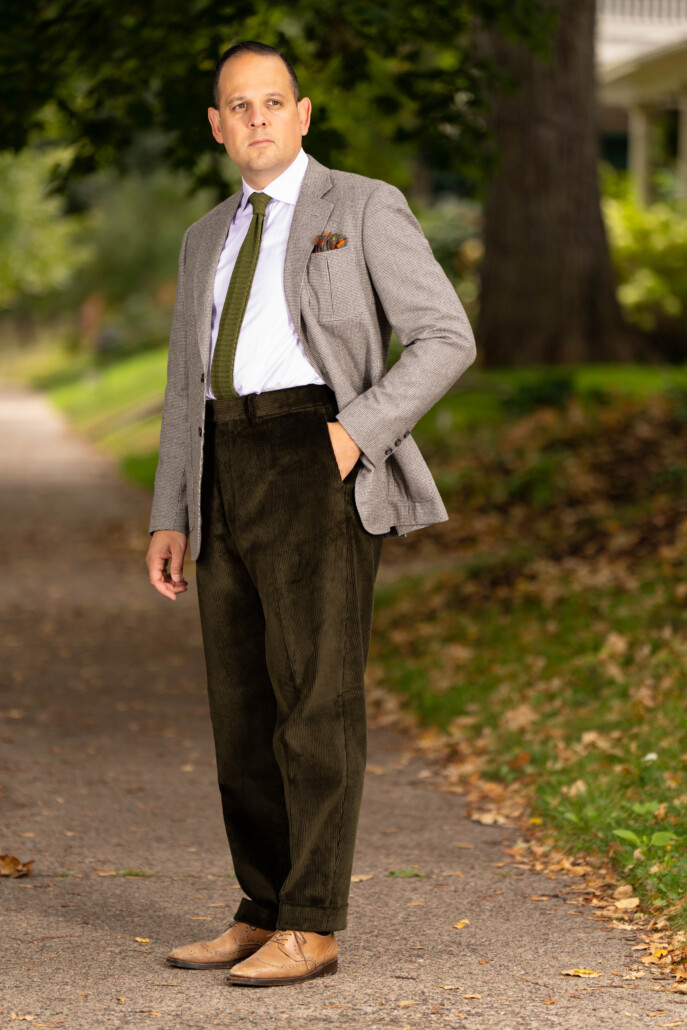
Let’s plop these dark olive corduroys into a martini!Take a gray sport coat and a white shirt with a dark green knit tie; add an orange, red, and green pocket square for visual interest. Light tan derbies complete the look with a pair of green and purple socks.
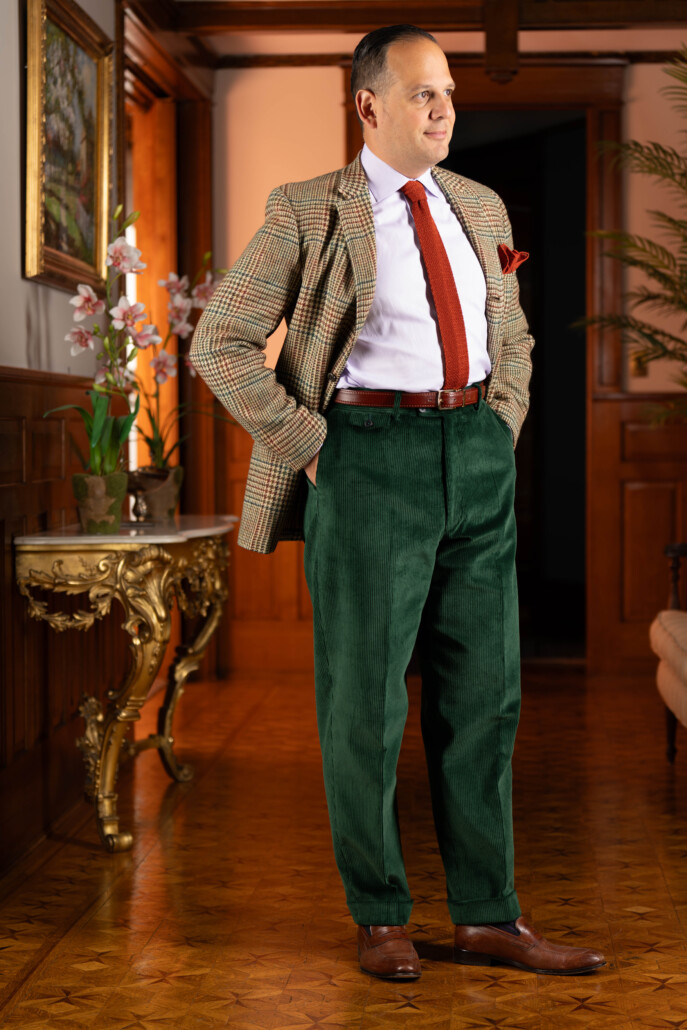
You’re off to the races with these British racing green corduroys. Start with a vibrant green, red, and buff houndstooth sport coat, then add an orange knit tie perfectly harmonized with a green and orange polka dot pocket square. A tan belt pairs with light brown loafers that transition beautifully from the trousers thanks to purple and dark green socks.
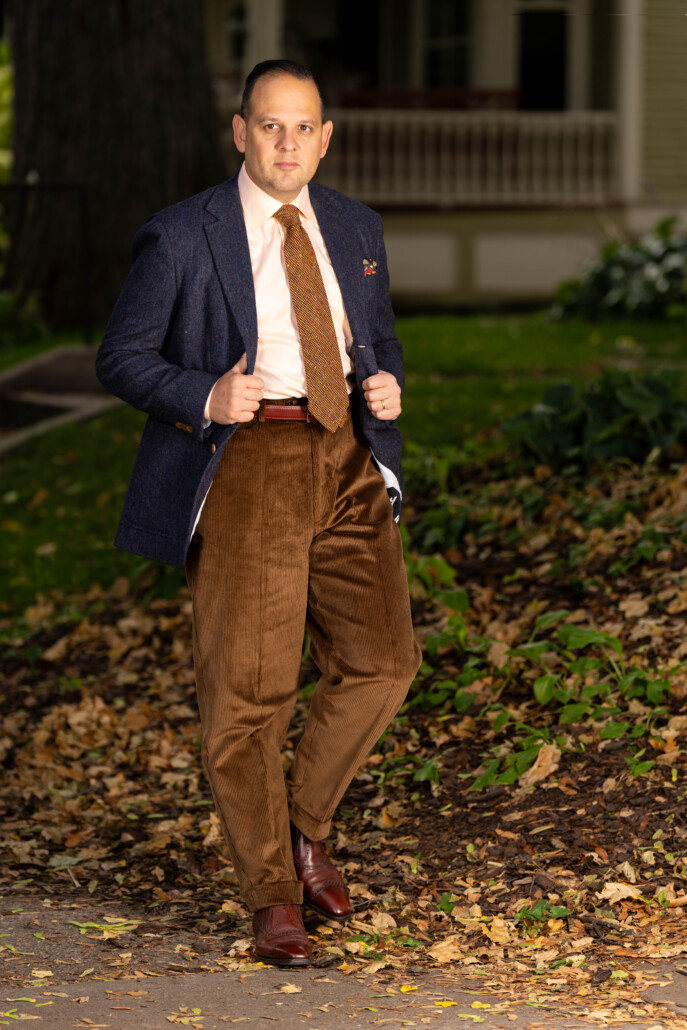
For a fall fling in these cognac corduroy trousers, consider a textured dark navy blazer set off by a mottled orange tie and off-white shirt: our Egyptian Revival pocket square in yellow picks up these colors beautifully. Finish the look off with cognac slip-ons worn with dark brown and beige socks and a chestnut belt.
Check out our lookbooks for more style inspiration!
Pairing Corduroy Trousers with Socks
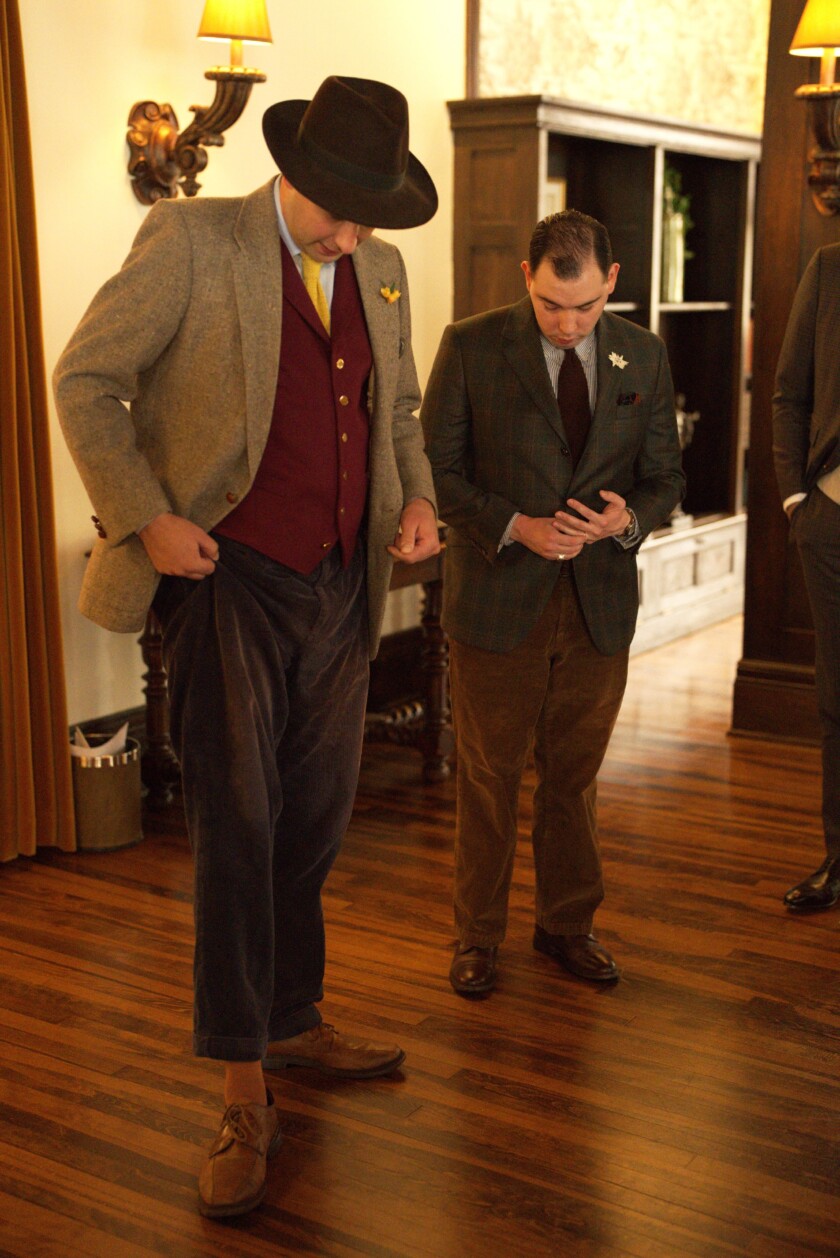
You’ll take advantage of every chance to show off when wearing fine corduroy trousers.
Thanks to their visual weight and ability to assume a tonally diverse appearance due to their subtle and lustrous nap, corduroy trousers can be paired with dress socks in a wide array of colors, fabrics, and styles. Corduroy will allow you to tone down bold socks and shoes or craft a more cohesive look: the choice is yours.
Get Your Corduroy and Socks from Fort Belvedere!
Download our free guide to sock pairing!
How to Care for Corduroy
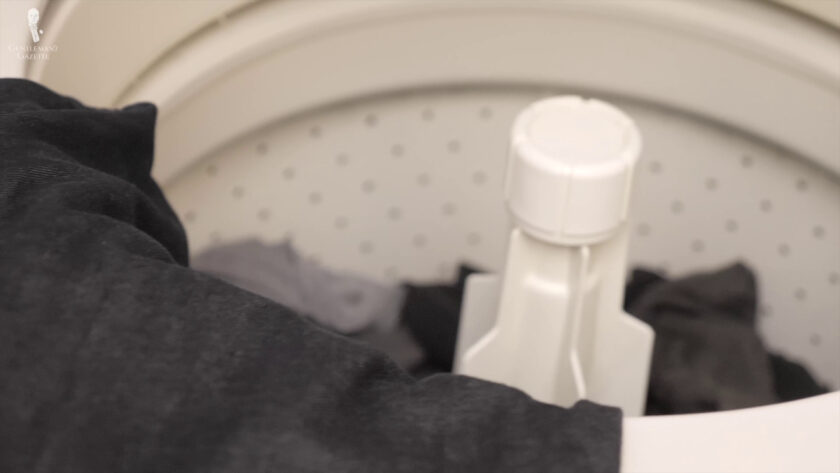
Always read the care label before washing any corduroy garment.
Always follow the particular cleaning instructions for your corduroy garments. In general, and especially if the corduroy is dyed a vibrant color, avoid washing your corduroy at home and instead take it out periodically for dry-cleaning, along with spot cleaning.
For paired corduroy garments, like suit trousers and a jacket, be sure to always have them cleaned together, to prevent one item from fading more quickly than the other and therefore appearing disjointed.
Understand the basics of dry cleaning!
Conclusion
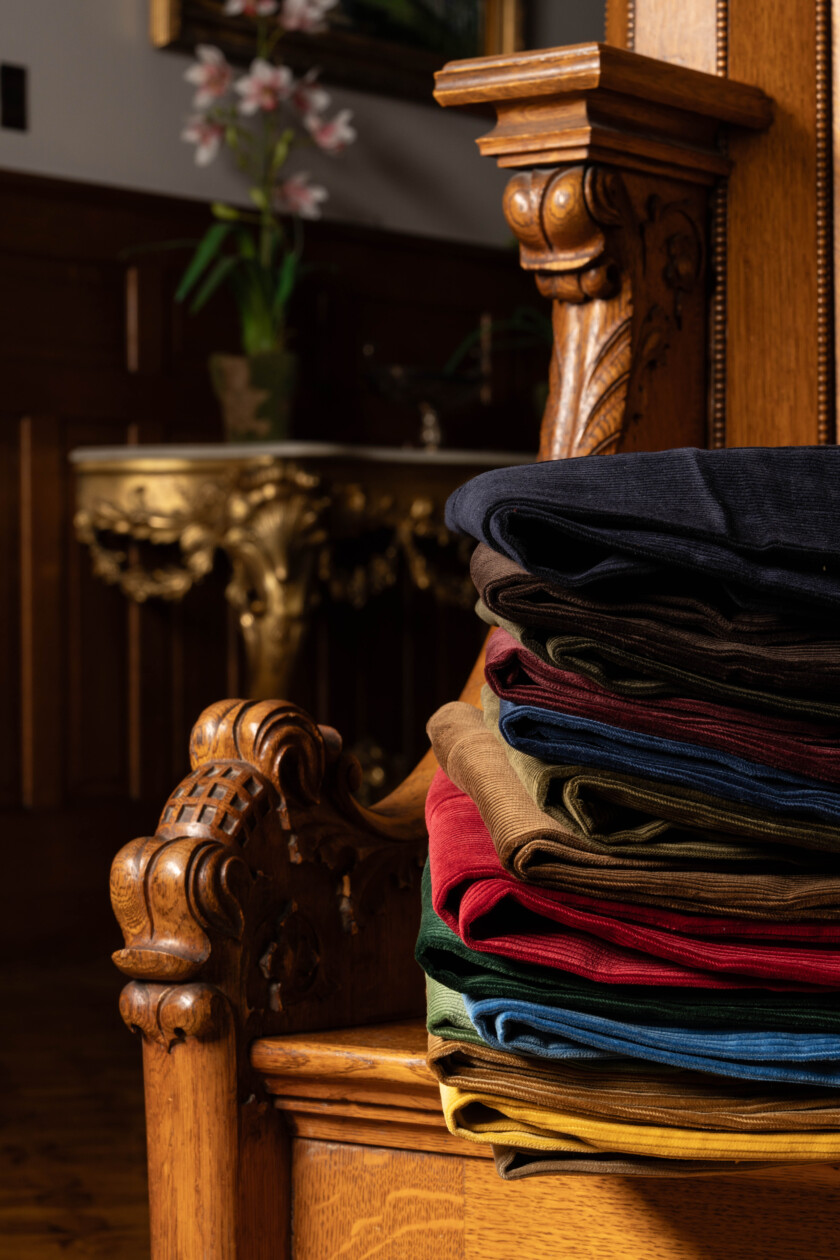
Unlock the effortless elegance of corduroy today!
Now that you have learned more about the history and styling potential of corduroy, we hope that you have a fuller appreciation for the versatility and potential of this unique textile. Made into jackets, trousers, or suits, corduroy is a refined and long-lasting material that is able to carry you through your day, no matter where you are. So whether you’re shooting on a country estate or enjoying a walk through the park, we hope that you’ll be doing it in corduroy, a truly “royal” fabric!
How do you like to incorporate corduroy into your ensembles?
The Finest Corduroy Trousers
We Are Proud to Offer Corduroy Trousers from Fort Belvedere, a Name that You Know and Trust in Classic Menswear

How many Fort Belvedere trousers do you own?
Invest in the epitome of luxury with Stancliffe corduroy trousers from Fort Belvedere. These trousers, inspired by the Golden Age of Menswear, offer a comfortable high-rise fit and full cut for all body types. Made in Italy from 100% long-staple cotton, this corduroy fabric boasts a robust 705 grams per meter cloth that drapes beautifully. With a 20,000 double-rub certification, these pants are built to last.
Available in 14 different shades, there’s a style for every mood, season, or occasion.
Meticulously assembled by heritage artisans in Portugal, our trousers feature a flat front design that accentuates the verticality of the cords. The true high-rise waist with an elegant double-button closure adds sophistication. Our corduroys reflect actual human dimensions, offering roomier hips and waist for larger sizes and tapered legs for smaller sizes.
We offer eight sizes, ranging from a slim 28-inch up to a 42-inch waist. Your Stancliffe corduroys will arrive unhemmed with ample reserve fabric for alterations. They feature two front pockets, a ticket pocket, buttoned rear pockets, and belt loops accommodating all classic belt widths. Experience the excellence for yourself – if you’re not satisfied, we offer free and hassle-free returns.
https://www.gentlemansgazette.com/corduroy-guide/
 Backyard GrillingWeekend WarriorsAdvice from DadBeard GroomingTV Shows for Guys4x4 Off-Road CarsMens FashionSports NewsAncient Archeology World NewsPrivacy PolicyTerms And Conditions
Backyard GrillingWeekend WarriorsAdvice from DadBeard GroomingTV Shows for Guys4x4 Off-Road CarsMens FashionSports NewsAncient Archeology World NewsPrivacy PolicyTerms And Conditions
